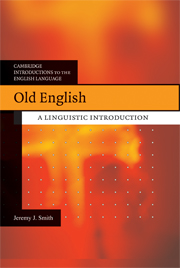Book contents
- Frontmatter
- Contents
- List of Figures
- Preface
- Notations and Conventions
- 1 About Old English
- 2 Describing Language
- 3 The Structure of Old English
- 4 Spellings and Sounds
- 5 The Old English Lexicon
- 6 Old English Grammar I: Syntax
- 7 Old English Grammar II: Inflexional Morphology
- Appendix 1 Texts
- Appendix 2 Discussion Questions and Further Reading
- Glossary of Old English–Present-Day English
- Glossary of Key Terms
- References
- Index
Preface
Published online by Cambridge University Press: 05 June 2012
- Frontmatter
- Contents
- List of Figures
- Preface
- Notations and Conventions
- 1 About Old English
- 2 Describing Language
- 3 The Structure of Old English
- 4 Spellings and Sounds
- 5 The Old English Lexicon
- 6 Old English Grammar I: Syntax
- 7 Old English Grammar II: Inflexional Morphology
- Appendix 1 Texts
- Appendix 2 Discussion Questions and Further Reading
- Glossary of Old English–Present-Day English
- Glossary of Key Terms
- References
- Index
Summary
This book is designed for the use of undergraduate and postgraduate students who wish to understand the linguistic structure of Old English. It is designed as a bridge between elementary primers (e.g. Hough and Corbett 2006, Hogg 2002, the OE sections of Smith 2005, and classic and still useful outlines such as Sweet/Davis 1953) and more advanced discursive works (e.g. Lass 1994) and OE grammars (e.g. Campbell 1959, Hogg 1992). I envisage the book being used, at a fairly early stage, as part of a general programme in English historical linguistics or (it is hoped) wider Germanic philology.
This book was commissioned some time ago, and since I undertook it other publications have appeared which cover some of the same ground. Perhaps the most important of these, and certainly the best, is McCully and Hilles 2005, which is designed with a similar audience in mind. However, I see my book as complementary to such works; it derives its orientation from ‘traditional’ philology (though drawing, of course, on more recent scholarship), and it is laid out as a resource rather than in units. Although, happily, old antagonisms between traditional approaches and more ‘modern’ linguistics are now receding, there is maybe a place for an approach which tries to synthesise long-established and more recent scholarship, accessible to scholars of both backgrounds.
Materials in this book derive from courses I have taught in English historical linguistics over the last twenty years, and I am most grateful to undergraduate and postgraduate students and colleagues who have used and commented on them.
- Type
- Chapter
- Information
- Old EnglishA Linguistic Introduction, pp. ixPublisher: Cambridge University PressPrint publication year: 2009

